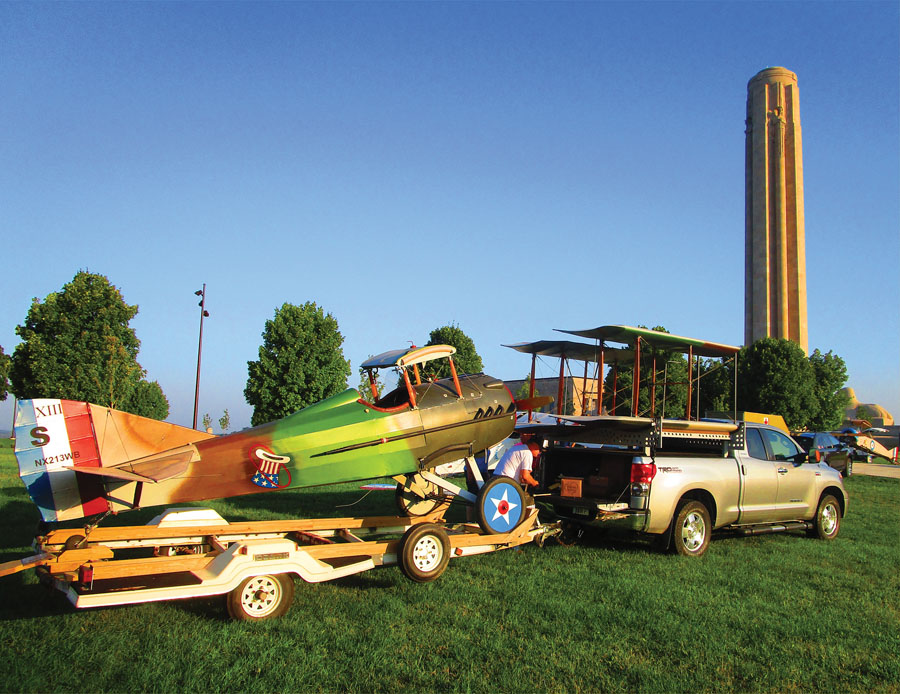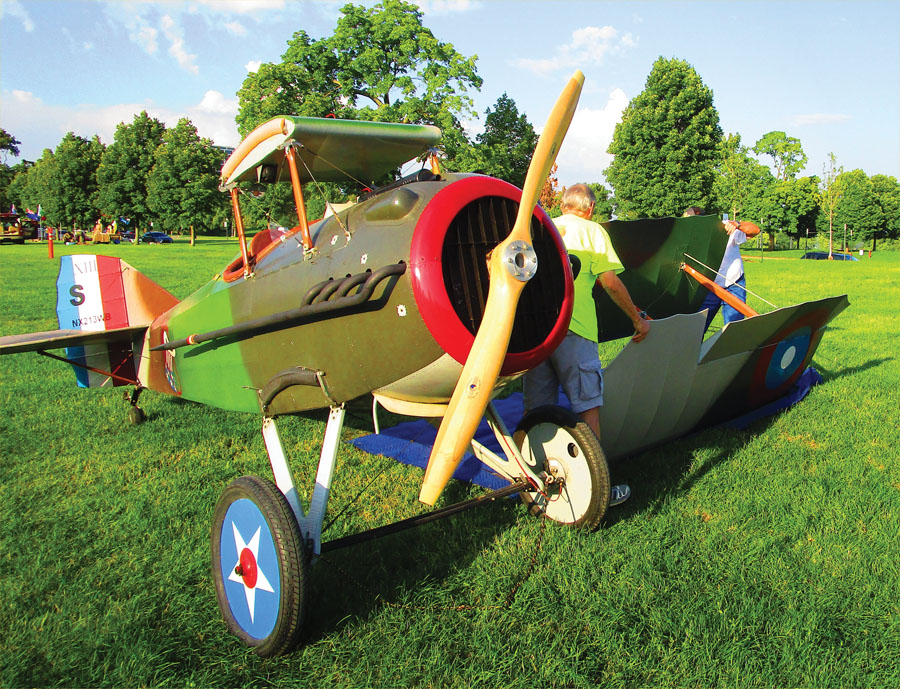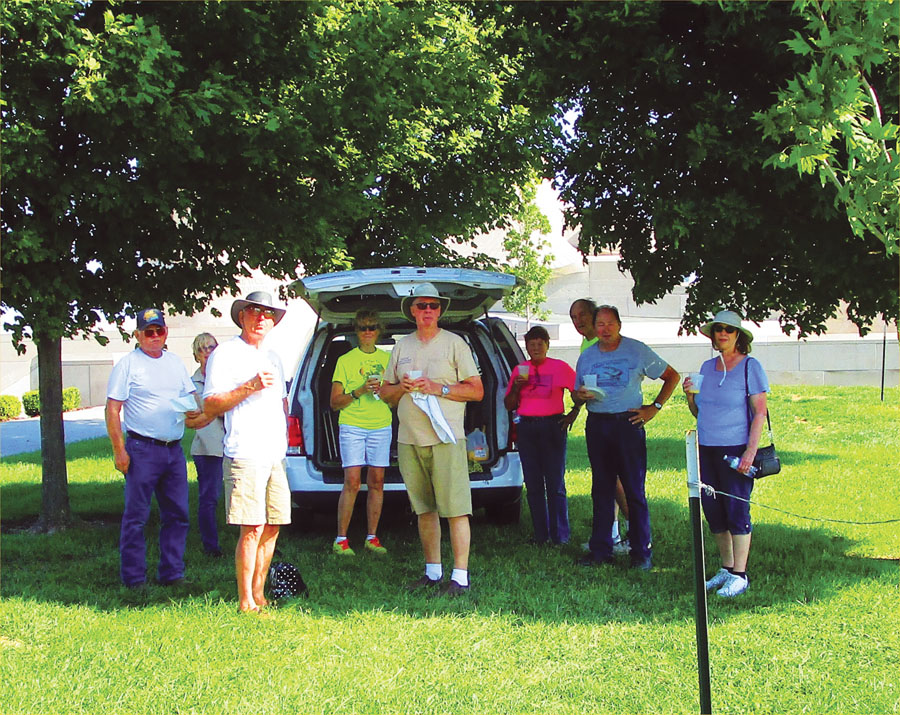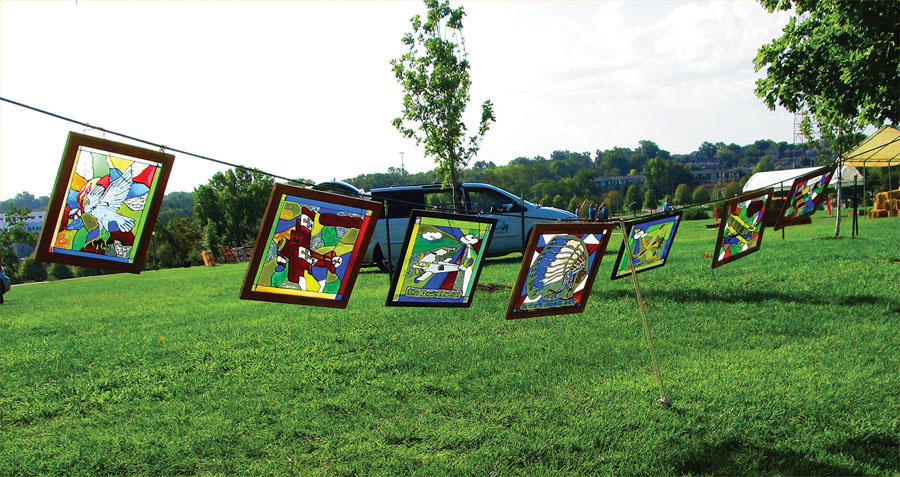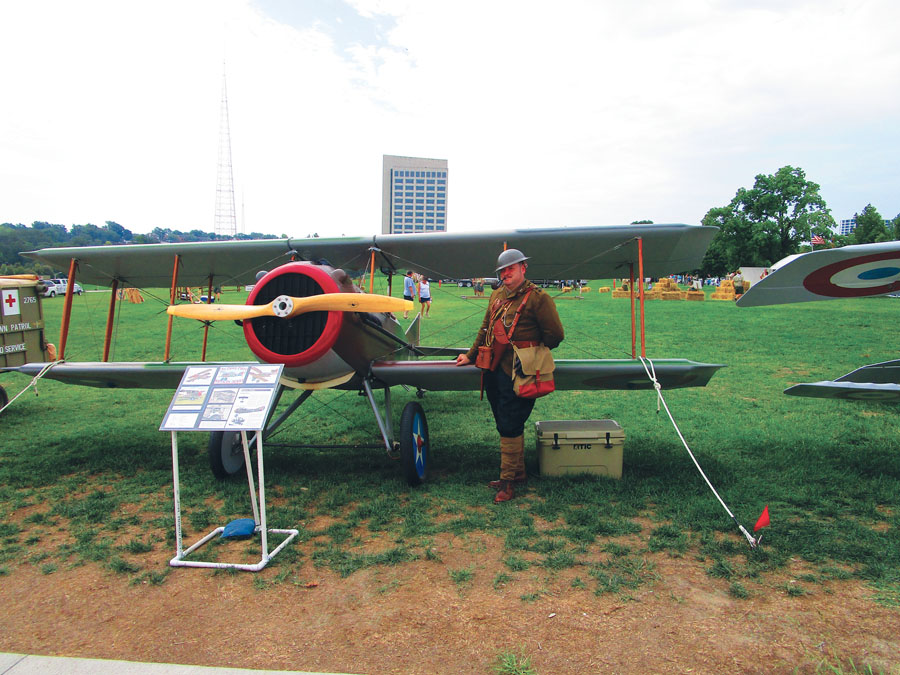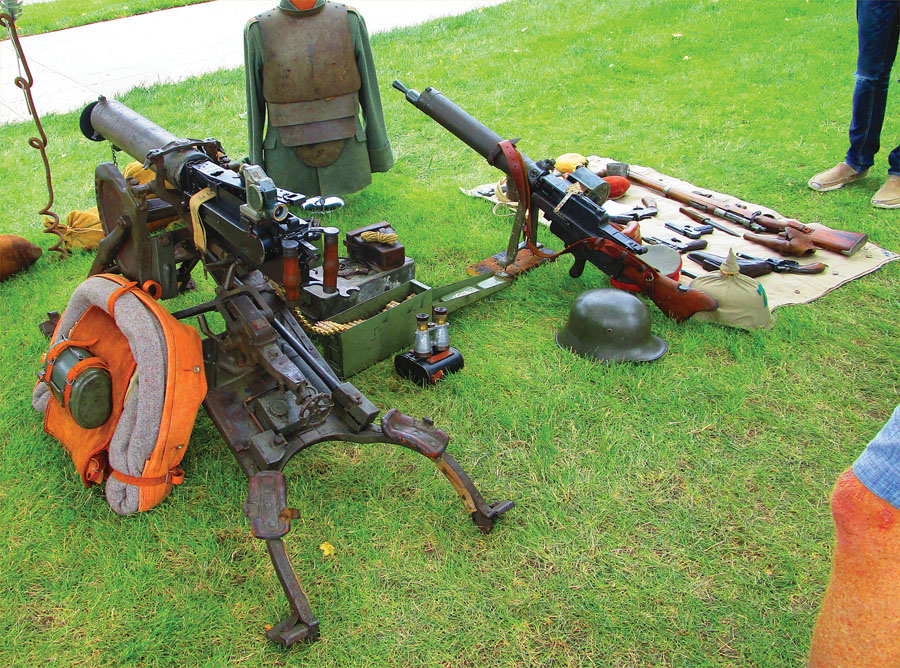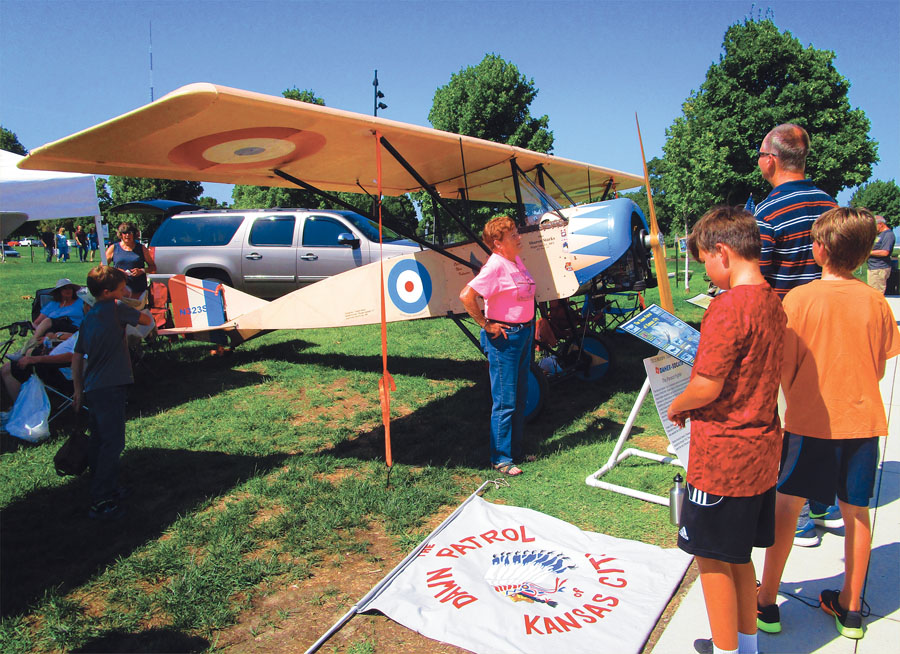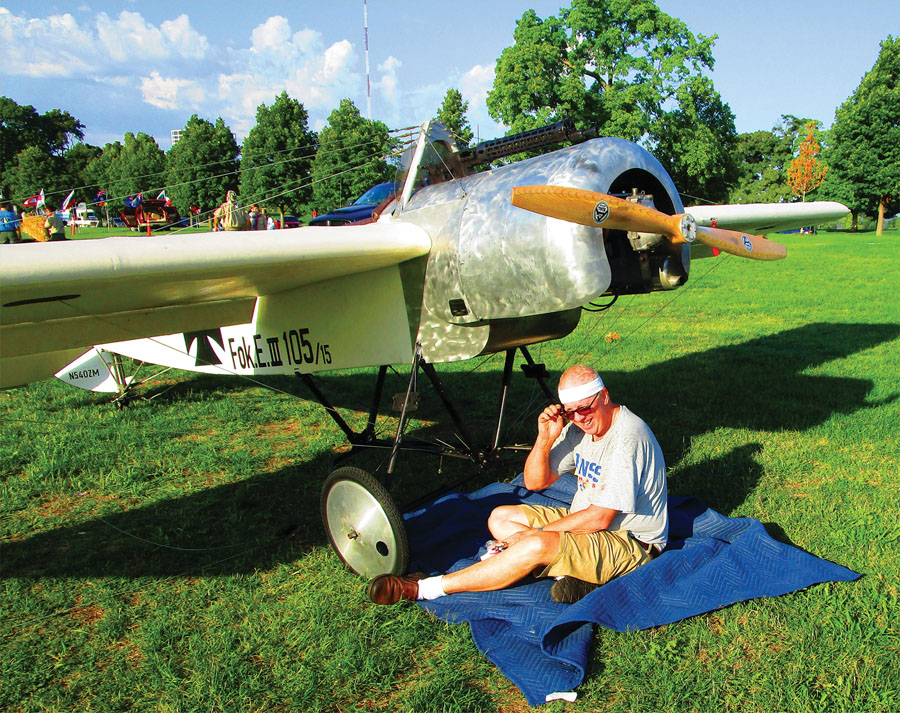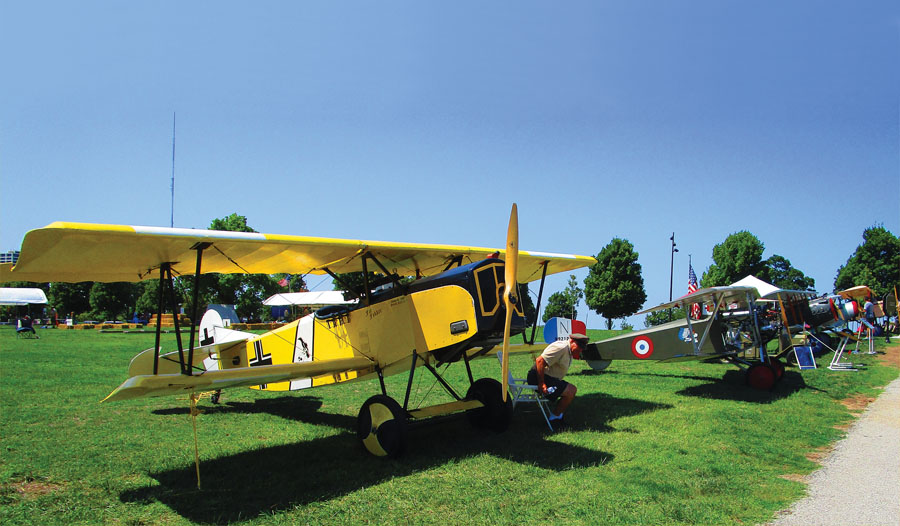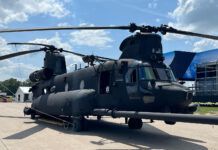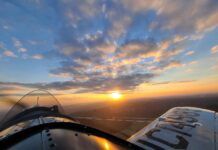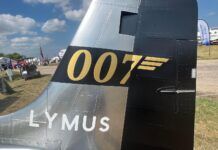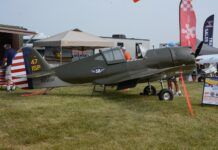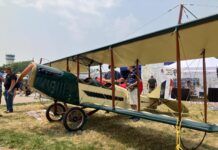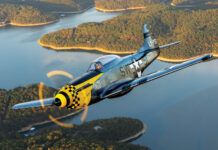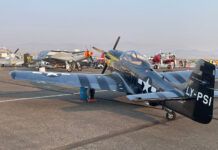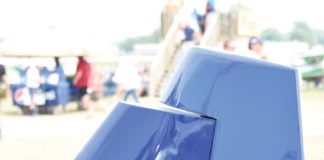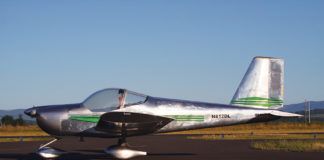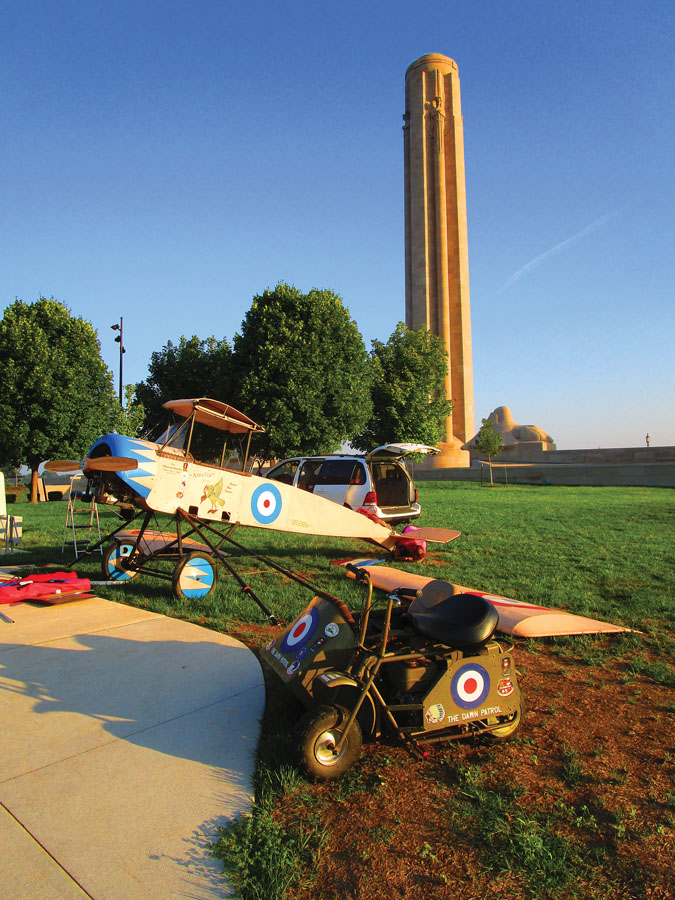
Clank! Another empty champagne bottle went into the trash can. It was number five (I think…My mind, after several breakfast mimosas, was getting a little fuzzy.)
Sweetie came over and murmured in my ear, “How many bottles of champagne do we have left in the cooler?”
“We have one left, My Little Commandant.”
“I’m gonna start stretching the orange juice,” she muttered. “By now none of these drunks will know the difference anyway.”
Marvin Berk pulls up in the really neat road setup he developed for his SPAD XIII. It’s a beautiful plane.
As a mixologist my little “Love Monkey” was what you’d call “generous” with the mixins.’ Her idea of a mimosa was fill the glass almost to the top with champagne, and add just enough orange juice to give it a little color. It was a lethal mixture to be sure. It helped to be sitting down leaning on something while drinking one, especially after previously drinking several. (Less distance to fall, you see.)
I sat there happily in the shade, propped up against a convenient tree. I was pondering the difference between now and when we were here the last time.
The Dawn Patrol was on the loose again and revisiting a place we’d been to several times before but in entirely different circumstances. Last time we’d been here was for the centennial commemoration of the entrance of the United States into the Great War. It was April 6, 2017. The temperature was 37 degrees with winds gusting to 45 mph. We’d been freezing our soaking wet toes off.
This time…wooeee…what a difference. The forecast was for blazing sunshine, wet wool blanket humidity, and a heat index over 100 degrees. Of course, this was Missouri in August, so duh…What else should we have expected. The forecast gusty winds were going to be a blessing and a curse. They would help with the heat, but mounting and dismounting the wings on the Trailer Weenies’ planes was going to be an “all hands on deck!”
But we were here, and what a “here” it was. We were on the grounds of the National WWI Museum and Memorial in Kansas City.
What a splendiferous museum it is, too! The tall concrete Liberty Memorial Tower looks out over Kansas City and the surrounding area. The museum at the base of the tower is a world-class venue I’d compare nose to nose to any museum in the world. The museum is so big, you really can’t do it justice in one day. Fortunately, a pass is good for two days.
This time, we’d been invited to display our birds on the grounds for an event called “Living the Great War.” This included WW-I reenactors in full original (heavy wool) uniforms and weaponry. There was even a replica WW-I boot camp obstacle course that you could try out.
The Dawn Patrol was there in force with six planes: Mark Pierce’s Nieuport 16, Dick Hartzler’s Nieuport 17, Darryl Porter’s Fokker D.VII, Charlie Radford’s Fokker E.III, Marvin Berk’s SPAD XIII and Sharon Starks’s Morane-Saulnier L Parasol. The rest of our display included our faux stained glass images of the Dawn Patrol’s WW-I planes, our WW-I Model T Ford replica ambulance, WW-I posters and the Trench Cat.
To make our display go really over the top, Mark Pierce had even rigged up a sound system playing original WW-I music. (My two favorite music pieces are Marlene Dietrich’s Lili Marlene in German and English, and John McCormack’s There’s a Long, Long Trail.)
We were invited to display our planes and other goods Saturday and Sunday. The event started at 10 a.m. both days when the museum opened. The organizers said they’d like us to be ready to go at 10, so we planned to be there at 7, get the planes assembled and staked out, and have everything ready to go before the museum opened.
Because “Bullwhip” Baslee had designed the Morane to be a quick setup using only clevis pins and clips, we were able to have it off the trailer, assembled, and staked out in 45 minutes. By then the rest of the mob was starting to trickle in, and aircraft assembly started with a flurry. We all wanted to be ready to go, well before the museum opened at 10 because there was another very important Liberty Memorial tradition that had to be observed.
(Left) Mimosas for breakfast. From left to right: Marvin Berk, Brenda Pierce, Carl Melin, Elaine Wheeler, Charlie Radford, Sharon Starks, Steve Kennamore, Mark Pierce, and Nancy Berk. At this time of the morning the mind-numbing heat of the day was just starting to build.
Mimosas for Breakfast
Every time we’d attended a function at the Liberty Memorial, hot or cold, we started off the day with mimosas for breakfast. That’s the really neat thing about being at a venue where there will be no flying. Breakfast mimosas with cheese, sausage, and crackers is one heck of a nice way to start the day.
Sweetie and I had brought six bottles of champagne, a gallon of orange juice, glasses, plates of cheese and crackers, and another platter of sliced summer sausage.
The unwritten rule at beautiful Liberty Landing International Airport is no bottle or can of drinks stronger than Diet Dr. Thunder can be opened until the planes are put away and hangar doors are closed.
At the Liberty Memorial the rule is similar. Nothing stronger than water is opened or poured until the last plane is assembled and staked down. We were all avidly watching Marvin Berk hammering in the last tie-down stake on his SPAD XIII. The last blow of the hammer was followed by the battle cry yell, “Yee-haw! Mimosas are being poured. Come and get ’em!”
The ravening herd descended on the “table” at the rear of the Stealth Van like a flock of buzzards landing on road kill. It was not a pretty sight.
Sunday was the same way. Brenda Pierce was in charge of the goodies that day, and the scene was exactly the same—pandelerium. Word had gotten out, and we had some new faces show up for the festivities. This time we did run out of champagne and orange juice.
As we were swilling down the mimosas, I looked fondly around at our band of brothers and sisters, and it suddenly dawned on me that we were members of a group of old raggedy-assed pilots. The “youngest” member of our herd at the Memorial gathering was 65 years old. No wonder we sit down and huff and puff a lot. When it’s time for us to get up and go over by the planes, the snap, crackle, and pop of old joints complaining sounds like someone pouring milk over a really big bowl of Rice Krispies.
“Why,” I hear you ask, were we there doing this? Easy…We have WW-I replica aircraft. We’re the Trailer Weenies. That means we can easily take our planes apart and display them in places where you can’t fly them in and out. This is one of the many great perks of having a WW-I replica aircraft. You get asked to go everywhere; it’s so neat being wanted!
We realized very soon after building our little warbirds that they were not good cross-country aircraft. When Tom Glaeser and I flew our Nieuports to Oshkosh in 1986, our average ground speed was 37 mph. Coming home we really tore up the air with an average ground speed of 44 mph. I thought I was going to die. We got passed by a dump truck on a gravel road.
The greatest perk of being a Trailer Weenie means you get there and back. At many airshows, pilots of other WW-I aircraft have come up to us and sneered at us for driving to the show. When I asked them why their planes weren’t at the event, they said the weather was too bad to fly them to the show.
We were there. They weren’t. I rest my case.
Sharon Starks was always surrounded by crowds of visitors wanting details about her Airdrome Aeroplanes Morane-Saulnier L Parasol.
Risky Business
When I said we couldn’t fly them into the Liberty Memorial, I didn’t say we couldn’t “physically” fly in and out of there. The grounds of the memorial are a lot bigger and better maintained than many small airports we’ve flown into. We could easily land and take off from several of the memorial’s golf-course-smooth grassy areas. There’s no way we would though. If you lost your engine on climb-out you’re totally screwed. There’s nowhere to put down. If you did, by some miracle of masterful pilotage, get it down with no damage, I’m betting the first responders on the scene would be a car filled with some outraged FAA minions armed with clipboards and waving eager pens dripping red ink. Then you’d become a for-real trailer weenie…probably for a really long time, too.
Charlie Radford hooks up the flying wires on his Airdrome Aeroplanes Fokker E.III with its new modified wing.
But let’s get back to the “Living the Great War” event. The gates opened and the crowds started arriving. Soon we were doing our usual airshow duties, putting people in and out of the cockpits of our planes and telling them about the plane’s history. Our posters are always being read and then the questions start coming.
Sharon was always surrounded by viewers around her Morane because a smokin’ hot, drop-dead-gorgeous, good-looking woman pilot flying her own homebuilt WW-I plane is a rarity.
The Trench Cat was a popular photo-op stop. The seats were rarely empty.
While Sweetie was holding court by her Morane, I wandered down the line of shade trees, looking at the reenactors and their displays of WW-I weaponry, tools, food, and memorabilia.
Life wasn’t easy in the trenches. In fact, downright brutal might be the better description.
Darryl Porter’s magnificent Airdrome Aeroplanes Fokker D.VII replica. The D.VII was arguably the best fighter used in WW-I. It was still in production in 1929 and used in every European air force.
The most popular display there was the WW-I boot camp obstacle course. Put up by Shawnee, Kansas, Boy Scout Troop 93, it was truly impressive. It started out with hay bales you had to climb over to simulate going “over the top” of a trench. Then you had to make your way across a mine field, traverse mock beams over trenches, crawl under real looking but safe barbed wire, throw dummy grenades, do some jumping jacks, leap a shell crater, bayonet a hanging dummy (with fierce yelling), crawl under more barbed wire, and then climb over another pile of hay bales to get back into the trench. It made us tired watching them do it.
The high point for us was watching a mother beat the pants off her teenage son in a head-to-head race to get through the course. He’d started off with an attitude about racing his mother. But when she slithered like a greased snake through the first barbed wire obstacle well ahead of him, the attitude disappeared in a flash. Later on, he ran the course again several times and got slower every time. His mom had an admiring crowd of other parents around her showering compliments on her. Sweetie and I loved it.
On Sunday, the event was scheduled to end at 3 o’clock. So we started breaking down planes and displays at 2 p.m. We had an audience just as large watching us do this—especially in winds gusting to 25 mph. That made it really interesting.
But with a crowd of ready helping hands, it was a non-event. This was our last “event” scheduled for the year. Then it was back to lazy-afternoon fall flying at Liberty Landing International Airport. Hours and hours of touch and goes on cool fall evenings is a heck of a way to end the day.
The adventure continues and this, by golly, is the way to do it!

